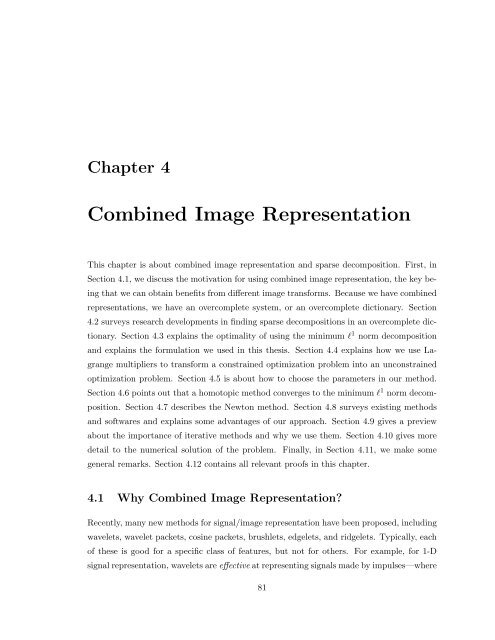sparse image representation via combined transforms - Convex ...
sparse image representation via combined transforms - Convex ...
sparse image representation via combined transforms - Convex ...
Create successful ePaper yourself
Turn your PDF publications into a flip-book with our unique Google optimized e-Paper software.
Chapter 4<br />
Combined Image Representation<br />
This chapter is about <strong>combined</strong> <strong>image</strong> <strong>representation</strong> and <strong>sparse</strong> decomposition. First, in<br />
Section 4.1, we discuss the motivation for using <strong>combined</strong> <strong>image</strong> <strong>representation</strong>, the key being<br />
that we can obtain benefits from different <strong>image</strong> <strong>transforms</strong>. Because we have <strong>combined</strong><br />
<strong>representation</strong>s, we have an overcomplete system, or an overcomplete dictionary. Section<br />
4.2 surveys research developments in finding <strong>sparse</strong> decompositions in an overcomplete dictionary.<br />
Section 4.3 explains the optimality of using the minimum l 1 norm decomposition<br />
and explains the formulation we used in this thesis. Section 4.4 explains how we use Lagrange<br />
multipliers to transform a constrained optimization problem into an unconstrained<br />
optimization problem. Section 4.5 is about how to choose the parameters in our method.<br />
Section 4.6 points out that a homotopic method converges to the minimum l 1 norm decomposition.<br />
Section 4.7 describes the Newton method. Section 4.8 surveys existing methods<br />
and softwares and explains some advantages of our approach. Section 4.9 gives a preview<br />
about the importance of iterative methods and why we use them. Section 4.10 gives more<br />
detail to the numerical solution of the problem. Finally, in Section 4.11, we make some<br />
general remarks. Section 4.12 contains all relevant proofs in this chapter.<br />
4.1 Why Combined Image Representation?<br />
Recently, many new methods for signal/<strong>image</strong> <strong>representation</strong> have been proposed, including<br />
wavelets, wavelet packets, cosine packets, brushlets, edgelets, and ridgelets. Typically, each<br />
of these is good for a specific class of features, but not for others. For example, for 1-D<br />
signal <strong>representation</strong>, wavelets are effective at representing signals made by impulses—where<br />
81
















